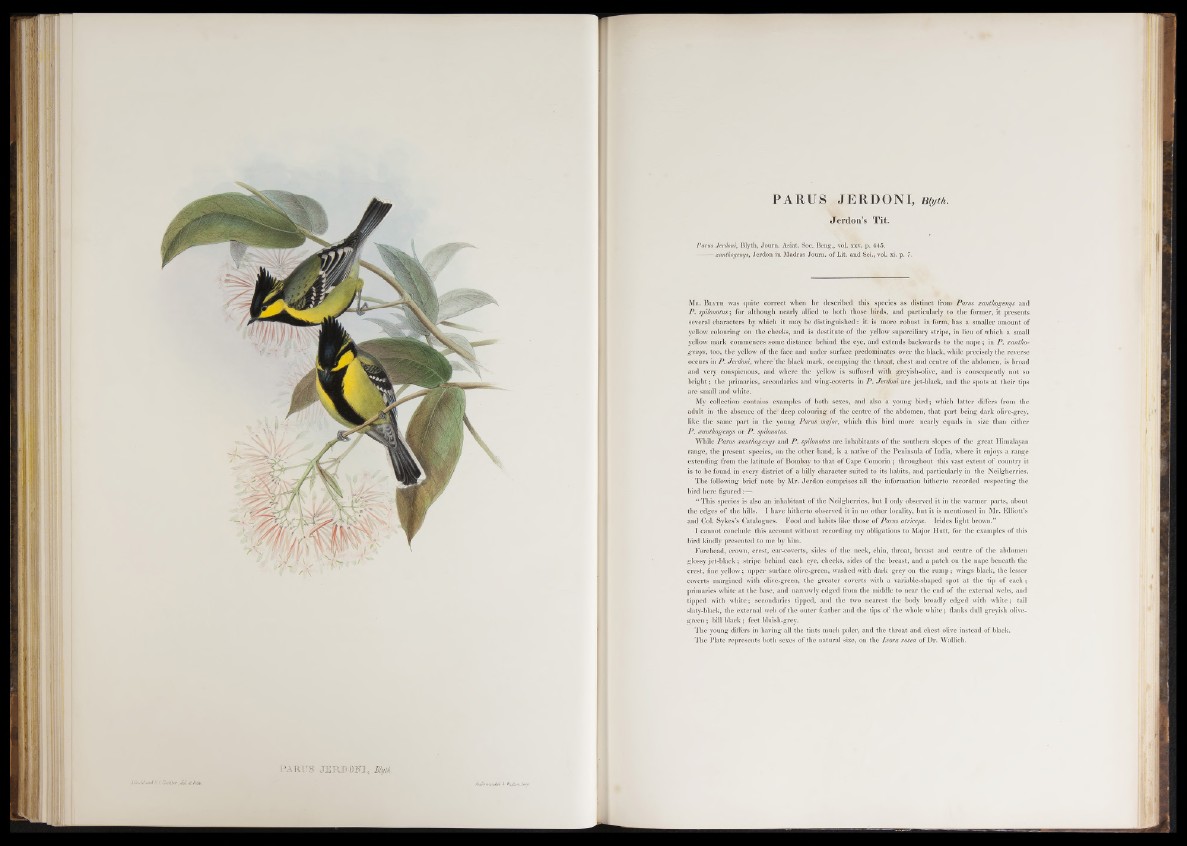
PARUS JE R B O M , BM
P A R U S J E R D O N I , myth.
Jerdon’s Tit.
Parus Jerdoni, Blyth, Joum. Asiat. Soc.. Beng., vol. xxv. p. 445.
xanthogenys, Jerdon in Madras Joum. of Lit. and Sci., vol. xi. p. 7.
Mb. B lyth was quite correct when he described this species as distinct from Parus xanthogenys and
P . spilonotus; for although nearly allied to both those birds, and particularly to the former, it presents
several characters by which it may be distinguished: it is more robust in form, has a smaller amount of
yellow colouring on the cheeks, and is destitute of the yellow superciliary stripe, in lieu o f which a small
yellow mark commences some distance behind the eye, and extends backwards to the n ap e ; in P . xanthogenys,
too, the yellow o f the face and under surface predominates over the black, while precisely the reverse
occurs in P . Jerdoni, where the black mark, occupying the throat, chest and centre o f the abdomen, is broad
and very conspicuous, and where the yellow is suffused with greyish-olive, and is consequently not so
b rig h t; the primaries, secondaries and wing-coverts in P . Jerdoni are jet-black, and the spots a t their tips
are small and white.
My collection contains examples of both sexes, and also a young b ird ; which latter differs from the
adult in the absence of the’ deep colouring of the centre of the abdomen, that part being dark olive-grey,
like the same p art in the young Parus major, which this bird more nearly equals in size than either
P . xanthogenys or P . spilonotus.
While Parus xanthogenys and P . spilonotus are inhabitants of the southern slopes o f the great Himalayan
range, the present species, on the other hand, is a native o f the Peninsula of India, where it enjoys a range
extending from the latitude of Bombay to that o f Cape Comorin; throughout this vast extent of country it
is to be found in every district of a hilly character suited to its habits, and particularly in the Neilgherries.
The following brief note by Mr. Jerdon comprises all the information hitherto recorded respecting the
bird here figured:—
“ This species is also an inhabitant of the Neilgherries, but I only observed it in the warmer parts, about
the edges of the hills. I have hitherto observed it in no other locality, but it is mentioned in Mr. Elliott’s
and Col. Sykes’s Catalogues. Food and habits like those o f Parus atriceps. Irides light brown.”
I cannot conclude this account without recording my obligations to Major Hutt, for the examples of this
bird kindly presented to me by him.
Forehead, crown, crest, ear-coverts, sides of the neck, chin, throat, breast and centre o f the abdomen
glossy jet-black; stripe behind each eye, cheeks, sides of the breast, and a patch on the nape beneath the
crest, fine yellow; upper surface olive-green, washed with dark grey on the rum p ; wings black, the lesser
coverts margined with olive-green, the greater coverts with a variable-shaped spot at the tip o f each ;
primaries white at the base, and narrowly edged from the middle to near the end of the external webs, and
tipped with white; secondaries tipped, and the two nearest the body broadly edged with white; tail
slaty-black, the external web of the outer feather and the tips of the whole white; flanks dull greyish olive-
green ; bill black ; feet bluish-grey.
The young differs in having all the tints much paler, and the throat and chest olive instead of black.
The Plate represents both sexes of the natural size, on the Ixora rosea of Dr. Wallich.